The Bulldozer Review: AMD FX-8150 Tested
by Anand Lal Shimpi on October 12, 2011 1:27 AM ESTPower Management and Real Turbo Core
Like Llano, Bulldozer incorporates significant clock and power gating throughout its design. Power gating allows individual idle cores to be almost completely powered down, opening up headroom for active cores to be throttled up above and beyond their base operating frequency. Intel's calls this dynamic clock speed adjustment Turbo Boost, while AMD refers to it as Turbo Core.
The Phenom II X6 featured a rudimentary version of Turbo Core without any power gating. As a result, Turbo Core was hardly active in those processors and when it was on, it didn't stay active for very long at all.
Bulldozer's Turbo Core is far more robust. While it still uses Llano's digital estimation method of determining power consumption (e.g. the CPU knows ALU operation x consumes y-watts of power), the results should be far more tangible than what we've seen from any high-end AMD processor in the past.
Turbo Core's granularity hasn't changed with the move to Bulldozer however. If half (or fewer) of the processor cores are active, max turbo is allowed. If any more cores are active, a lower turbo frequency can be selected. Those are the only two frequencies available above the base frequency.
AMD doesn't currently have a Turbo Core monitoring utility so we turned to Core Temp to record CPU frequency while running various workloads to measure the impact of Turbo Core on Bulldozer compared to Phenom II X6 and Sandy Bridge.
First let's pick a heavily threaded workload: our x264 HD benchmark. Each run of our x264 test is composed of two passes: a lightly threaded first pass that analyzes the video, and a heavily threaded second pass that performs the actual encode. Our test runs four times before outputting a result. I measured the frequency of Core 0 over the duration of the test.
Let's start with the Phenom II X6 1100T. By default the 1100T should run at 3.3GHz, but with half or fewer cores enabled it can turbo up to 3.7GHz. If Turbo Core is able to work, I'd expect to see some jumps up to 3.7GHz during the lightly threaded passes of our x264 test:
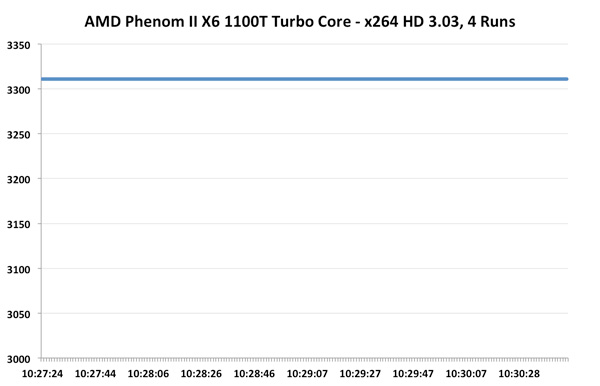
Unfortunately we see nothing of the sort. Turbo Core is pretty much non-functional on the Phenom II X6, at least running this workload. Average clock speed is a meager 3.31GHz, just barely above stock and likely only due to ASUS being aggressive with its clocking.
Now let's look at the FX-8150 with Turbo Core. The base clock here is 3.6GHz, max turbo is 4.2GHz and the intermediate turbo is 3.9GHz:
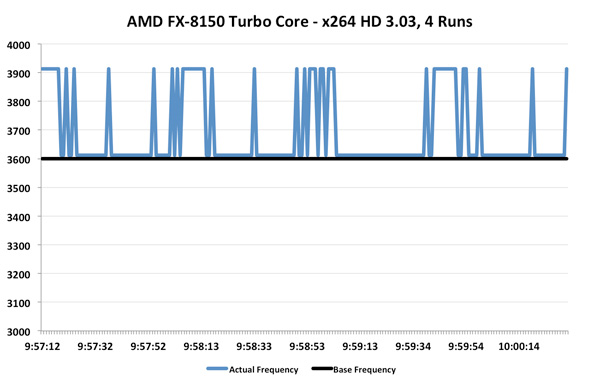
Ah that's more like it. While the average is only 3.69GHz (+2.5% over stock), we're actually seeing some movement here. This workload in particular is hard on any processor as you'll see from Intel's 2500K below:
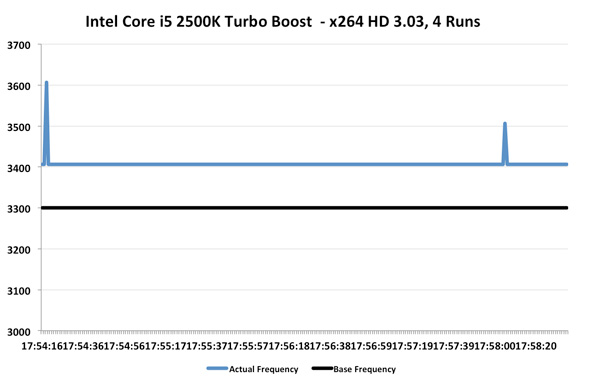
The 2500K runs at 3.3GHz by default, but thanks to turbo it averages 3.41GHz for the duration of this test. We even see a couple of jumps to 3.5 and 3.6GHz. Intel's turbo is a bit more consistent than AMD's, but average clock increase is quite similar at 3%.
Now let's look at the best case scenario for turbo: a heavy single threaded application. A single demanding application, even for a brief period of time, is really where these turbo modes can truly shine. Turbo helps launch applications quicker, make windows appear faster and make an easy time of churning through bursty workloads.
We turn to our usual favorite Cinebench 11.5, as it has an excellent single-threaded benchmark built in. Once again we start with the Phenom II X6 1100T:
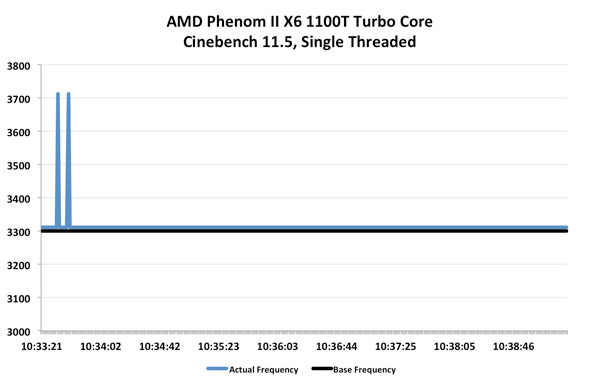
Turbo Core actually works on the Phenom II X6, albeit for a very short duration. We see a couple of blips up to 3.7GHz but the rest of the time the chip remains at 3.3GHz. Average clock speed is once again, 3.31GHz.
Bulldozer does far better:

Here we see blips up to 4.2GHz and pretty consistent performance at 3.9GHz, exactly what you'd expect. Average clock speed is 3.93GHz, a full 9% above the 3.6GHz base clock of the FX-8150.

Intel's turbo fluctuates much more frequently here, moving between 3.4GHz and 3.6GHz as it runs into TDP limits. The average clock speed remains at 3.5GHz, or a 6% increase over the base. For the first time ever, AMD actually does a better job at scaling frequency via turbo than Intel. While I would like to see more granular turbo options, it's clear that Turbo Core is a real feature in Bulldozer and not the half-hearted attempt we got with Phenom II X6. I measured the performance gains due to Turbo Core across a number of our benchmarks:

Average performance increased by just under 5% across our tests. It's nothing earth shattering, but it's a start. Don't forget how unassuming the first implementations of Turbo Boost were on Intel architectures. I do hope with future generations we may see even more significant gains from Turbo Core on Bulldozer derivatives.
Independent Clock Frequencies
When AMD introduced the original Phenom processor it promised more energy efficient execution by being able to clock each core independently. You could have a heavy workload running on Core 0 at 2.6GHz, while Core 3 ran a lighter thread at 1.6GHz. In practice, we felt Phenom's asynchronous clocking was a burden as the CPU/OS scheduler combination would sometimes take too long to ramp up a core to a higher frequency when needed. The result, at least back then, was that you'd get significantly lower performance in these workloads that shuffled threads from one core to the next. The problem was so bad that AMD abandoned asynchronous clocking altogether in Phenom II.
The feature is back in Bulldozer, and this time AMD believes it will be problem free. The first major change is with Windows 7, core parking should keep some threads from haphazardly dancing around all available cores. The second change is that Bulldozer can ramp frequencies up and down much quicker than the original Phenom ever could. Chalk that up to a side benefit of Turbo Core being a major part of the architecture this time around.
Asynchronous clocking in Bulldozer hasn't proven to be a burden in any of our tests thus far, however I'm reluctant to embrace it as an advantage just yet. At least not until we've had some more experience with the feature under our belts.


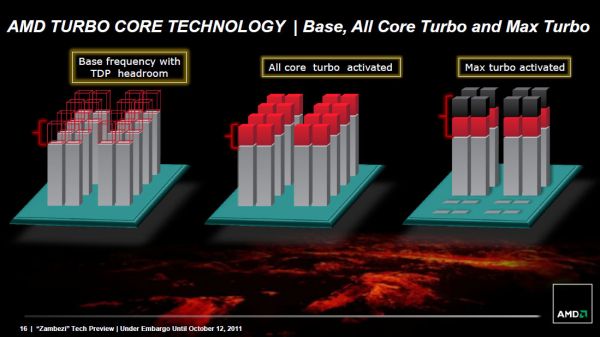








430 Comments
View All Comments
B3an - Wednesday, October 12, 2011 - link
Yep this really is extremely disappointing. I'm actually going to call this AMD's Pentium 4. Thats how bad this is.2 billion transistors - thats a massive increase over the Phenom II X6 and what do we get? Nothing. The Phenom II is atleast as good with WAY less transistors and lower power consumption under load. I'm pretty shocked at how bad Bulldozer is. I wasn't expecting performance clock for clock to be as good as Nehalem, let alone Sandy Bridge, but this is just... appalling. When Ivy Bridge is out the performance difference is going to be MASSIVE.
Intel are surely going to implement more restrictions and hold there clocks speeds back even further. Theres just no competition anymore. Sad day for consumers.
bennyg - Wednesday, October 12, 2011 - link
AMD's Prescott to be exact... ironically that's one thing they seemed to shoot for in deepening pipeline and hoping that process would be better... hopefully this is just immature and soon there will be a GF110-style refresh that does it properly...Otherwise the whole next gen of AMD CPUs will continue to fight for scraps at the bottom of the heap... and their laptop CPUs will not even succeed there.
TekDemon - Wednesday, October 12, 2011 - link
I don't even know if it's just the process since those power consumption figures seem to suggest that they're being limited by the sheer amount of power it's using and the heat being generated from that. Intel had planned to take the P4 to 10Ghz but the fact that it was a power hog prevented that from realistically happening and it seems like you have the same issue here. The clockspeed potential is clearly there since it can hit 7Ghz under liquid nitrogen but for a normal air heatsink setup this is a recipe for failure. It's just way too power hungry and not fast enough to justify it. Why would anybody choose to use an extra 100 watts for largely the same or worse performance vs an i5 2500K?Thermalzeal - Wednesday, October 12, 2011 - link
I agree, 2 billion transistors are doing what exactly?The worst thing is that the water cooler isn't included with the FX-8150. At the performance levels they are providing, they should have just upped the price 30-50 bucks and provided the cooler gratis. Who's gonna need an AMD branded cooler if their not going to buy bulldozer?
The other point of these review is that there is no availability of any of the parts. So what a wonderful paper launch we have here. Seems like AMD isn't betting on anyone being interested enough to buy one of these things.
Blasphemy.
eanazag - Wednesday, October 12, 2011 - link
You can find them on Newegg today. The price is jacked up though. Newegg must not read AT.jleach1 - Friday, October 21, 2011 - link
Sigh...it's quite sad. There must be actual people buying these...either that or the supply is terrible. Because there's no way in hell i'd pay those prices for an AMD processor.defacer - Wednesday, October 12, 2011 - link
Like most people here, I 'm disappointed with BD performance -- even though I have never owned an AMD CPU after my 386DX/40 myself, competition in the performance segment would be nice for a change.I won't argue against "it's not 8 core", but calling it a 4-core is IMHO just as inappropriate (if not more).
yankeeDDL - Wednesday, October 12, 2011 - link
Ok, how about 4 modules, with 8 integer EU, 4 fetch, 4 decode, 4 L2 caches ...Point being, they are 4 modules, not 8 cores, and from many aspects, they are more similar to a 4-core CPU than to an 8-core CPU, being neither one (somewhere in between).
The fact of the matter remains: the IPC is bad. In multi-threaded, Integer-intensive tasks, BD should crunch the PhenomII X6 (2 more cores, higher clock speed), but it seems you can hardly see the difference. (ref: Excel 2007 SP! MonteCarlo sims).
AMD now is left with Llano as the only compelling reason to buy AMD over Intel (for netbooks and small notebooks, where Atom is the contender).
Against Core, either the FX-8150 goes down to $200 or less, or the i5-2500 is just a better buy for the money.
The advantage is I don't need a new MoBo (huge advantage for me, but not very compelling, in general).
yankeeDDL - Wednesday, October 12, 2011 - link
Forgot to mention, regarding the integer-intensive test: the core-i5 is slower by about 9% slower with 9% slower clock, but only 4 execution units (8 logical, with hyperthreading, but hyperthreading should be nearly irrelevant in this test).What a blow.
Ratman6161 - Wednesday, October 12, 2011 - link
We can argue about weather its really a 4 core or an 8 core, and the argument is interesting from a technical standpoint. But the proof is in the real world benchmarks. From a practical standpoint, if the benchmarks are not there (and they aren't) then the rest really doesn't matter.I looked on Microcenter where you can get a 2600K for $279 and a 2500K for $179. An i5-2400 is only $149. So AMD is going to be right back to having to cut prices and have its top end CPU go up against $149 - $179 Intel parts. Worse yet, it will, at least initially, be competing against its own previous generation parts.
There is one point of interest though and that is the fact that all the FX's are unlocked (according to the story). So it's pretty likely that an FX 8100 will probably overclock about as high as an 8150 once the process is mature. But there again, among overclockers, AMD could find its highest end 8150 competing against its own lower priced 8100.
Back in the day, I loved my Athlon 64's and 64 x2's and even though I have switched to an Intel Q6600 and then a 2600K, I still really want AMD to succeed...but its not looking good.